Although Beethoven did not write as many pieces of music as Haydn or Mozart, he has a far higher ratio of masterpieces. In a way, his output was like a distilled liqueur with more strength and potency.
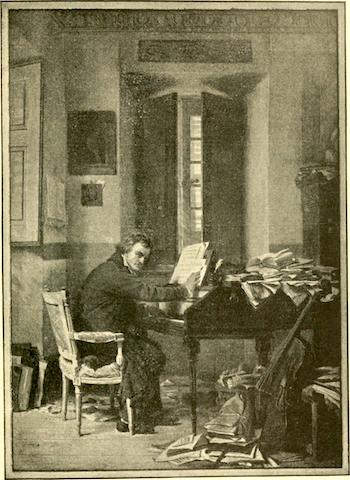
As you may already have realized from listening to him, Beethoven changed the structures of classical form by giving them new expanse and flexibility. He brought to music depths of expressiveness it had not known before.
We have said that Beethoven’s artistic career is commonly divided into three periods: Early, Middle, and Late.
The Early Period, ending in about 1800, was one in which he generally used the forms and idioms of Haydn and Mozart—although it must be emphasized that his own strong personality was even then asserting itself.
Deafness brought on the Middle Period. “I am now making a fresh start,” he wrote at the time. In 1803 and 1804 alone he produced the Kreutzer Sonata for violin and piano, the Waldstein and the Appassionato sonatas for piano, and the Eroica Symphony No. 3. During this second period, he also composed the Fourth through Eighth symphonies, the opera Fidelio, the “Rasumovsky” Quartets, the Fourth and Fifth piano concertos, and the Violin Concerto (among many others).
With these works, musical form was raised to its highest point of development in the history of music. More importantly, Beethoven refined and enriched his own speech to a point where it was now touched with poetry.
After 1817 came Beethoven’s Late Period. This included the Ninth Symphony, the Missa Solemnis, and the last piano sonatas and string quartets. In these works, Beethoven becomes almost mystical, surveying the world in music that was highly unorthodox in form and style.
Although it is impossible in a short amount of time to survey such riches, you will be able to walk down enough paths to grasp the extent of his work. This should give you the ability to return and travel deeper into the endless splendors of his music.
In the following sections, we will give you samples from each of the three periods divided into different types of music. This should better enable you to see how he transformed music from the classical era into the romantic.
- Piano Sonatas
- Chamber Music
- String Quartets
- Symphonies
Please note that because there is so much music here, instead of telling you exactly what to listen to, you will be able to choose what movements and pieces to try. I recommend listening to at least the beginning of the first movement to get the overall feel for a piece.
A Note on Listening
From this point forward in the class, we will give you different options to listen to so you can explore a composer’s music on your own. This is, after all, how most people learn about classical music: they explore on their own. To that end, you can listen to different sections of pieces and choose what interests you.
Piano Sonatas
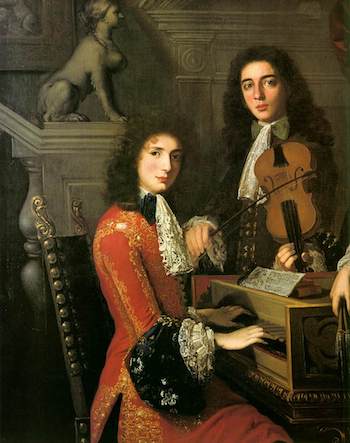
Haydn and Mozart wrote their sonatas with one eye on instructional usefulness*. Beethoven, however, considered the piano sonata exclusively as a medium for artistic expression. Thus he did not hesitate to experiment with the fullest resources of the piano keyboard, tapping into a richness of color and a technical range before unknown to it. He poured into the piano sonata some of his noblest thoughts and most daring attitudes.
Beethoven composed thirty-two sonatas for the piano. They are some of the most amazing music he wrote, endlessly engaging with the full spectrum of color and sounds. Numerically, they can be grouped into his three periods:
- Early: 1 to 15, plus 19 & 20 (written earlier, but published later)
- Middle: 16 to 27
- Late: 28 to 32
Piano Sonata No. 4, Op. 7 ‘Grand Sonata’ | Early Period
This sonata, which was published in 1798, clearly shows the influence of Haydn and Mozart. Yet even in his early works, the strong personality of Beethoven emerges. As Sir Henry Hadow puts it, speaking of the works of the early period, “It is eighteenth-century music raised to a higher power.”
The sonata is planned on a large scale, in four movements, and begins to feel almost “orchestral” in places—something that was characteristic of some of Beethoven’s chamber music.
Listen to Piano Sonata No. 4, Op. 7 ‘Grand Sonata’ (24 min)
Performed by Austrian pianist Rudolf Buchbinder. This is part of a series of all 32 sonatas performed by Mr. Buchbinder.
Timing: Mvt 1. Allegro – 0:30 | 2. Largo – 8:04 | 3. Allegro – 15:10 | 4. Rondo – 19:47
Piano Sonata No. 21, Op. 53 ‘Waldstein’ | Middle Period
In the Waldstein Sonata—so called because it was dedicated to Beethoven’s patron, Count Waldstein—the piano sonata begins to acquire new dimensions. The Waldstein is the first of Beethoven’s piano sonatas cast in that extended design which was to mark his greatest sonatas.
We find here, too, the more recognizable Beethoven: the Beethoven of fiery tempers and dramatic accent. The opening of the sonata at once plunges into a tempestuous mood, its fever heightened rather than relieved by a brief contrasting second subject suggesting a restless spirit come to rest. The mystic Beethoven is heard in the Adagio molto, a short introductory section that plumbs profound depths of feeling; and the exuberant and high-spirited Beethoven is heard in the Rondo. [A personal note: this is my favorite of Beethoven’s piano sonatas.]
Listen to Piano Sonata No. 21, Op. 53 ‘Waldstein’ (23 min)
Performed by the extraordinary Russian pianist Evgeny Kissin.
Timing: Mvt 1. Allegro con brio – 0:00 | 2. Adagio molto – 10:10 | 3. Rondo. Allegretto – 14:10
Piano Sonata No. 32, Op. 111 | Late Period
Beethoven’s last piano sonata was composed in 1822 and dedicated to the Archduke Rudolph. The last sonata sums up the whole experience gathered by Beethoven throughout all the sonata writing that had occupied him on and off for twenty-six years.
In his piano sonatas, Beethoven repeatedly showed a leaning toward fugal writing and toward theme-and-variations. Both of these forms are found in this sonata. The first movement, though in sonata form, is a free fugal fabric. The second, and closing, movement is a set of variations on a theme of other-worldly beauty.
Listen to Piano Sonata No. 32, Op. 111 (20 min)
A revelatory performance by Russian pianist Sviatoslav Richter in Moscow in 1973. There is a brief introduction in Russian, so start at 0:52. [Another personal note: Richter is my favorite pianist. Some have said he played Beethoven like Beethoven himself.]
Timing: Mvt 1. Maestoso – Allegro con brio ed appassionato – 0:52 | 2. Arietta: Adagio molto semplice e cantabile – 9:00
Chamber Music
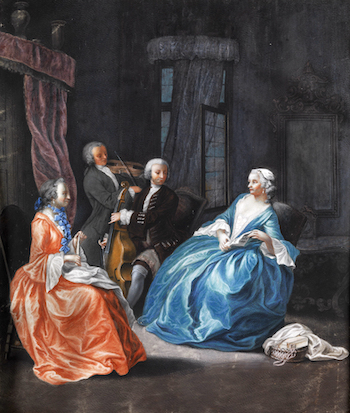
Septet, Op. 20 | Early Period
Beethoven’s septet is one of the pieces that often introduces listeners to the genre of chamber music. The scoring is for violin, viola, clarinet, horn, bassoon, cello, and double bass. Beethoven did not write again for such an ensemble, but turned either to the symphony or tighter, smaller groups.
The septet was written in the last months of 1799. It is a popular work of Beethoven’s and reveals the range of his early approach to chamber music. The minuet is similar to that of the little G major piano Sonata, Op. 49, No. 2 (the final movement). The subject of the theme-and-variations movement is probably taken from a lower Rhineland folk song.
Listen to Septet, Op. 20 (40 min)
Performed by members of WDR Sinfonieorchesters Köln. The seven instruments are, from left to right: violin, viola, cello, double bass, french horn, bassoon, and clarinet.
Timing: 1. Adagio – Allegro con brio – 00:00 | 2. Adagio cantabile – 10:41 | 3. Tempo di menuetto – 19:21 | 4. Tema con variazioni: Andante – 22:20 | 5. Scherzo: Allegro molto e vivace – 29:28 | 6. Andante con moto alla marcia – Presto – 32:38
Piano Trio ‘Archduke’ Op. 97 | Middle Period
The great Trio in B-flat Major, Op. 97, is a symphony scored for a piano trio. Its form is expansive, with its moods ranging from splendid pathos to quiet contemplation. It receives its nickname from its dedication to Beethoven’s friend and patron Archduke Rudolf.
The first movement is largely dominated by its impressive first theme. The second movement, a Scherzo, features an ascending scale as its thematic substance. In the third movement, Beethoven reverts to his well-known skill in the varying of an original theme. The finale of this trio rises to a quick presto, crowned by a chain of crystal clear trills played by the piano, along with a final, vivacious cadence.
Listen to Piano Trio ‘Archduke’ Op. 97 (41 min)
Performed in 1970 by one of the most famous trios of the 20th century: violinist Isaac Stern, cellist Leonard Rose, and pianist Eugene Istomin. Although each of these men had illustrious careers individually, they also played together perfectly.
Timing: 1. Allegro moderato – 0:00 | 2. Scherzo (Allegro) – 13:52 | 3. Andante cantabile ma però con moto – 21:14 | 4. Allegro moderato – 34:25
Fugue for String Quintet, Op. 137 | Late Period
Throughout his life, Beethoven was fascinated with fugues. He had grown up listening to Bach’s music, so he knew their wonderful power and their intellectual difficulty. As he grew older, he became more fascinated with them. This is the only piece he wrote for String Quintet during his late period. However, it is greatly overshadowed by his “Grosse Fugue” (Great Fugue), Op. 133, that he wrote as the finale for his String Quartet, Op. 132. He later removed the “Grosse Fugue” when musicians complained it was nearly impossible to play. (Note: although this fugue bears a late opus number, it is because it was published late – it was actually written in 1819, at the start of his late period.)
As you listen, notice how Beethoven is leaving the feel of his middle period and moving into a new landscape of sound.
Listen to Fugue for String Quintet, Op. 137 (2 min)
Performed by members for the Frankfurt Symphony Orchestra.
String Quartets
Beethoven wrote sixteen quartets. They are considered the greatest set of works in that branch of musical literature. Within the string quartet, even more than in the symphonies and piano sonatas, Beethoven uttered his profoundest and most intimate thoughts.
The quartet is capable of speaking pure musical language with a lucidity and clarity that made it particularly appropriate for voicing Beethoven’s most personal moods and ideas.
The sixteen quartets can be roughly divided into Beethoven’s three periods: the first, including the six Opus 18 quartets, represents the early Beethoven who absorbed the forms and speech of Haydn and Mozart, and then began to use them for his own purposes.
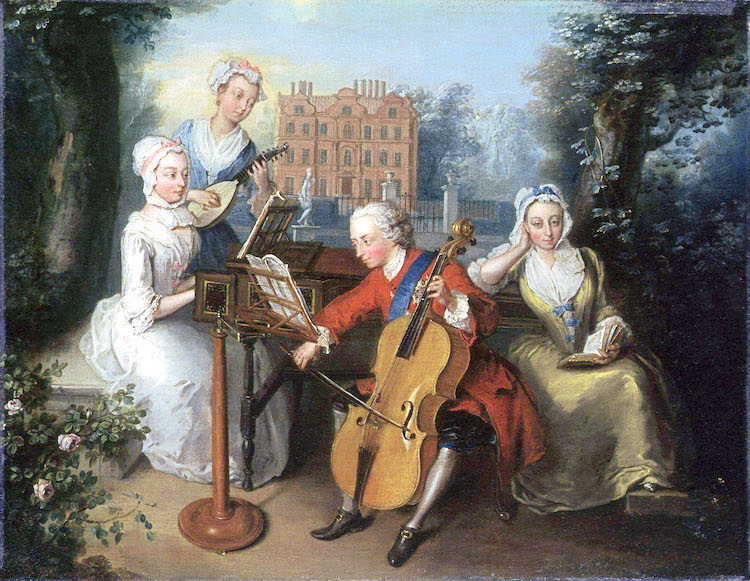
The second includes the Rasumovsky quartets Op. 59, the “Harp” Quartet Op. 74, and the “Serioso” Quartet Op. 95—these show the mature Beethoven of the fabulous middle period of his creative career. In the third group we find quartets Opp. 127, 130, 131, 132, 135, along with the Grosse Fuge. In these incredible works, Beethoven seems to be a mystic searching for new worlds and achieving a philosophic depth and sublimity never before heard in music.
String Quartets, Opus 18 | Early Period
The quartet’s first subject cost Beethoven no fewer than 16 pages of sketching, and even then he came back to it a year later for reworking. Although the links back to Mozart and Haydn are strong, in his first quartets he tried to achieve matching responsibility for each player—one of Beethoven’s many innovations for the quartet. He told a violinist friend that the slow movement of this quartet was inspired by the tomb scene in Shakespeare’s Romeo and Juliet.

The first movement has a serious intensity to it that is balanced carefully with a more carefree feel; Beethoven’s unique musical tensions are felt from the very beginning.
Listen to the String Quartet No.1 – Op, 18, No. 1 (28 min)
Performed by the Alban Berg quartet, one of the most famous quartets of the late 20th-century.
Timing: 1. Allegro con brio – 0:00 | 2. Adagio affettuoso ed appassionato – 9:30 | 3. Scherzo: Allegro molto – 18:52 | 4. Allegro – 22:20
The Rasumovsky String Quartets. Opus 59 | Middle Period
The classicism of the Op. 18 quartets is here succeeded by an ardent romanticism. The poetic idea in the Op. 59 quartets becomes more important than the form, and one feels throughout them that it is trying to shake itself free from the restrictions of formal structure. This is the Beethoven of the middle period, the volatile Beethoven who passes from stormy moods to moments of tranquillity.
This is Beethoven the dramatist, who can create suspense, build climaxes, and invoke surprising contrasts with an unerring sense for good theater. Above everything else, this is the poetic Beethoven, concerned first and foremost with the articulation of his innermost thoughts and reveries.
This quartet and the two others that come after it were written for a Russian Count living in Vienna. When the music to the quartet was first seen, a violinist asked if they were really to be considered as music. Beethoven answered, “Oh, they are not for you but for a later age!”
Listen to String Quartet No. 7 – Op. 59, No. 1 (41 min)
Performed by the Alban Berg quartet.
Timing: Mvt 1. Allegro – 0:00 | 2. Allegretto vivace e sempre scherzando – 10:30 | 3. Adagio molto e mesto – 21:30 | 4. Thème russe: Allegro – 34:42 (Note: there is no pause between movements 3 and 4)
String Quartet Op. 127 | Late Period
Beethoven had not written a string quartet for 14 years when he sat down to write this quartet, the first of his five famous “Late Quartets.” It is perhaps the most accessible of the five, with a beautiful, majestic “Maestoso” opening theme in the first movement. The second movement Adagio is like a gentle sunrise with its softness and light. The third movement Scherzo is curiously engaging with a slight tension below the surface. The fourth movement Finale seems to move in unusual circles around the theme, picking up and then moving on.
From here, his quartets grow more unusual and perhaps powerful. All five are considered some of the greatest music ever written.
Listen to String Quartet No. 12, Op. 127 (39 min)
Performed by the Alban Berg quartet.
Timing: 1. Maestoso – Allegro – 0:00 | 2. Adagio ma non troppo, molto cantabile – 7:30 | 3. Scherzando vivace – 24:30 | 4. Finale – 32:24
Symphonies
Mozart brought to the symphony an exquisite feeling for form and an unparalleled sense of tonal beauty. But Beethoven went further—not only in enlarging the symphonic structure, but also in enhancing the power of music to project profound feeling.
Beethoven’s Nine Symphonies are notable for the variety of poetic concepts found in them. The heroic epic of the Third Symphony stands between the lyric Second and the melancholic and gentle Fourth; the dramatic Fifth is partner to the pastoral Sixth; the powerful and intense Seventh is followed by the joyful and sprightly Eighth. These are all succeeded by the otherworldly Ninth, that celestial tribute to the brotherhood of man.
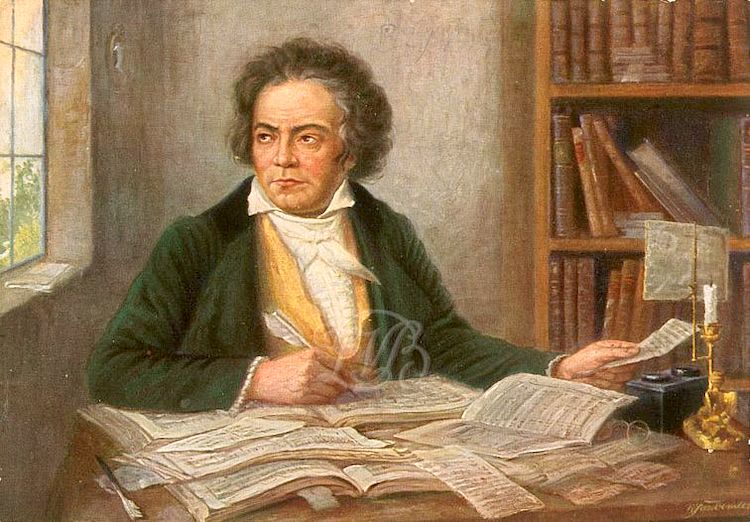
Symphony No. 1 in C Major, Op. 21 | Early Period
The First Symphony in C major. Op. 21 is sometimes loosely labeled “Mozartian.” Admittedly, its symphonic structure is more or less that of Mozart, and the subject of the second movement is reminiscent of the slow movement of Mozart’s G minor symphony.
But to use the term “Mozartian” for the work as a whole is to misunderstand it. For here the giant Beethoven already begins to stir restlessly; the very opening chord of the first movement reveals him as an iconoclast. Nevertheless, the overall symphony falls squarely into the classical tradition as Beethoven received it, with very few departures from its structures. It was given its premiere in Vienna on April 2, 1800, Beethoven himself conducting.
Listen to Symphony No. 1 in C major (29 min)
Performed by the Royal Concertgebouw Orchestra conducted by Iván Fischer.
Timing: 1. Adagio molto – Allegro con brio – 0:06 | 2. Andante cantabile con moto – 09:41 | 3. Menuetto: Allegro molto e vivace – Trio – 18:35 | 4. Finale: Adagio – Allegro molto e vivace – 22:19
Symphony No. 5 in C Minor | Middle Period
Beethoven himself described the opening theme of the first movement of the C minor Symphony, Op. 67, by saying: “Thus Fate knocks at the door.” With this as a clue, we are justified in reading into the symphony a musical depiction of Beethoven’s struggle with his fate of deafness.
But we need no program to understand the music of a movement like this one, which remains to this day one of the most remarkable examples of economy in the utilization of musical material. The opening subject is incredibly brief, yet out of it Beethoven builds music of breath-taking proportions, inevitable in its logic and overpowering in its force and strength.
The second movement is a set of variations on a beautiful and extended melodic subject.
The third movement, introduced by a brooding theme in the basses and cellos, is a Scherzo thats principal theme retains the rhythm of the “Fate” subject of the first movement.
The closing movement is a magnificent affirmation of the spirit of triumph that rewards the acceptance of one’s inevitable fate. It is proclaimed majestically by three trombones.
Listen to Symphony No. 5 in C Minor, Op. 67 (30 min)
A historic performance by one of the titans of the 20th century: Herbert von Karajan. As he grew older, his conducting sometimes slackened, but this recording from his early days is incredibly taut and strong. A powerful and rousing performance.
Timing: I. Allegro con brio – 0:00 | 2. Andante con moto – 6:58 | 3. Allegro – 16:12 | 4. Allegro – 20:45 (Note: there is no stop between the 3rd and 4th movements)
Symphony No. 9 “Choral” | Late Period
As early as 1793, Beethoven had aspired to set to music the German poet Schiller’s Ode to Joy—an expression of his own dream of the brotherhood of man. When the idea occurred to him to incorporate it into the framework of a symphony, he sketched it first as a slow movement, then as a scherzo.
Not until 1817, however, did he arrive at the appropriate design for the symphony, and the place that the ode should have in it. He did not begin intensive work upon it until 1823. The Symphony in D minor, Op. 125, was completed in the winter of 1823, and was fully scored by the spring of 1824. It was first performed at the Karntnerthortheater on May 7, 1824.
Beethoven, who was so deaf that he could not hear a note of music, insisted upon conducting the performance. The musicians agreed amongst themselves to disregard him and to keep their eyes fixed on Schuppanzigh, the concertmaster and choral director.
“Beethoven stood as if on a lonely island,” wrote a Swedish author, “and conducted the flood of his somber demoniac harmonies with the strangest of motions. Thus, for instance, he commanded pianissimo by kneeling and extending his arm downward to the floor; at fortissimo he then sprang up like an elastic bow, appeared to grow beyond his length, and opened his arms wide.”
In the last movement, Beethoven conducted more slowly than the tempo taken by the performers, so that when the music came to an end he was still beating time for its final measures. Fraulein Caroline Unger, one of the soloists, then took the Master gently by the arm, and with tears in her eyes turned him around to the audience to receive an ovation that he could not hear.
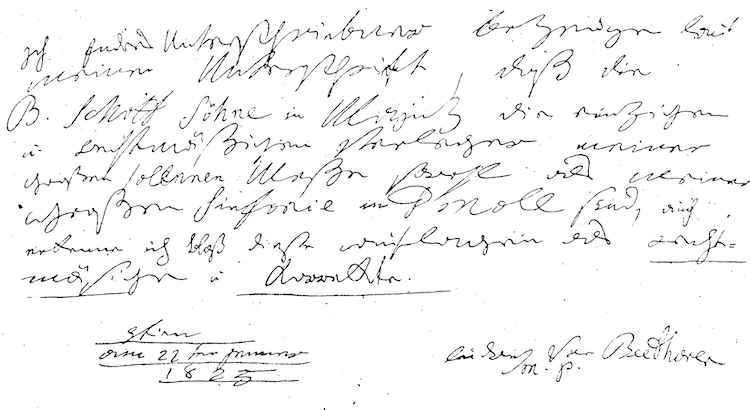
The Ninth Symphony is Beethoven’s highest flight of fancy in the symphonic form. It is one of the indestructible masterpieces throughout the entire realm of art. Nowhere before—not even in the Eroica—was Beethoven’s poetic speech so pregnant with meaning. The first movement states the first subject after sixteen introductory bars projecting a setting of awe and mystery. This subject is given a development of enormous outline, rising to heights of passion and dramatic power rare even with Beethoven.
The second movement is a Scherzo in a mood of rather hysterical joy. No nobler note of humanity, no more poignant note of compassion, and no more moving note of sublimity is sounded anywhere in music than in the third movement, an Adagio comprising two themes with their variations.
In the fourth movement, Beethoven ingeniously recapitulates the principal themes of the first three movements, then dismisses them as inadequate for his expression of joy. He next introduces a new melody which becomes the principal subject: the famous Ode to Joy.
First introduced by the cellos, then carried on by the violins, it is finally sung by the tenor to the words of Schiller’s ode after a brief exhortation by the baritone: “O brothers, no longer sound these sad tones, let us now raise our voices and sing of joy!” The choral passages include the Recitative (the opening exhortation for baritone), a Quartet and chorus (the first rendition of the Joy theme), a Tenor solo and Chorus, two more Choruses, a Quartet and Chorus, and a final Chorus in prestissimo(a very quick tempo).
It is absolutely necessary that you listen to this final movement: there is nothing comparable to it in the entire history of music.
Listen to Beethoven’s Symphony No. 9, “Choral” (120 min)
Performed by the Chicago Symphony Orchestra conducted by Ricardo Muti. See the dropdown below the video for German/English translation of the lyrics in the fourth movement.
Timing: Mvt 1. Allegro ma non troppo – 1:42 | 2. Molto Vivace – 19:44 | 3. Adagio – 35:45 | 4. Finale: Ode to Joy – 52:10

